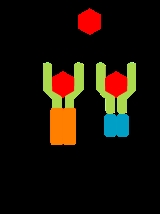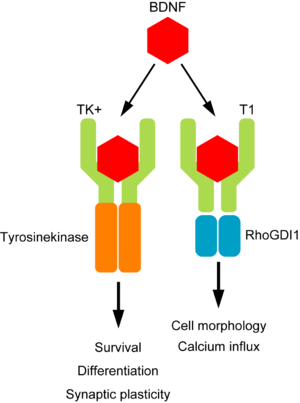
TrkB
Encyclopedia
TrkB receptor also known as TrkB tyrosine kinase or BDNF/NT-3 growth factors receptor or neurotrophic tyrosine kinase, receptor, type 2 is a protein
that in humans is encoded by the NTRK2 gene
.
for several "neurotrophin
s", which are small protein growth factors that induce the survival and differentiation of distinct cell populations. The neurotrophins that activate TrkB are: BDNF (Brain Derived Neurotrophic Factor), NT-4 (neurotrophin-4), and NT-3 (neurotrophin-3). As such, TrkB mediates the multiple effects of these neurotrophic factors, which includes neuronal differentiation and survival.
The TrkB receptor is part of the large family of receptor tyrosine kinases. A "tyrosine kinase
" is an enzyme which is capable of adding a phosphate group to certain tyrosines on target proteins, or "substrates". A receptor tyrosine kinase is a "tyrosine kinase" which is located at the cellular membrane, and is activated by binding of a ligand to the receptor's extracellular domain. Other examples of tyrosine kinase receptors include the insulin receptor
, the IGF1 receptor, the MuSK protein
receptor, the Vascular Endothelial Growth Factor (or VEGF) receptor, etc.
 Currently, there are three TrkB isoforms in the mammalian CNS. The full-length isoform (TK+) is a typical tyrosine kinase receptor, and transduces the BDNF signal via Ras-ERK, PI3K, and PLCγ. In contrast, two truncated isoforms (TK-: T1 and T2) possess the same extracellular domain, transmembrane domain, and first 12 intracellular amino acid sequences as TK+. However, the C-terminal sequences are the isoform-specific (11 and 9 amino acids, respectively). T1 has the original signaling cascade that is involved in the regulation of cell morphology and calcium influx.
Currently, there are three TrkB isoforms in the mammalian CNS. The full-length isoform (TK+) is a typical tyrosine kinase receptor, and transduces the BDNF signal via Ras-ERK, PI3K, and PLCγ. In contrast, two truncated isoforms (TK-: T1 and T2) possess the same extracellular domain, transmembrane domain, and first 12 intracellular amino acid sequences as TK+. However, the C-terminal sequences are the isoform-specific (11 and 9 amino acids, respectively). T1 has the original signaling cascade that is involved in the regulation of cell morphology and calcium influx.
and TrkC
. Also, there are other neurotrophic factors structurally related to BDNF: NGF (for Nerve Growth Factor
), NT-3 (for Neurotrophin-3) and NT-4 (for Neurotrophin-4). While TrkB mediates the effects of BDNF, NT-4 and NT-3, TrkA is bound and thereby activated only by NGF. Further, TrkC binds and is activated by NT-3.
TrkB binds BDNF and NT-4 more strongly than it binds NT-3. TrkC binds NT-3 more strongly than TrkB does.
with:
Protein
Proteins are biochemical compounds consisting of one or more polypeptides typically folded into a globular or fibrous form, facilitating a biological function. A polypeptide is a single linear polymer chain of amino acids bonded together by peptide bonds between the carboxyl and amino groups of...
that in humans is encoded by the NTRK2 gene
Gene
A gene is a molecular unit of heredity of a living organism. It is a name given to some stretches of DNA and RNA that code for a type of protein or for an RNA chain that has a function in the organism. Living beings depend on genes, as they specify all proteins and functional RNA chains...
.
Function
TrkB is the high affinity catalytic receptorCatalytic receptor
A Catalytic receptor is an integral membrane protein possessing both enzymatic catalytic and receptor functions.The following is a list of the five major families of catalytic receptors:...
for several "neurotrophin
Neurotrophin
Neurotrophins are a family of proteins that induce the survival, development, and function of neurons.They belong to a class of growth factors, secreted proteins that are capable of signaling particular cells to survive, differentiate, or grow. Growth factors such as neurotrophins that promote the...
s", which are small protein growth factors that induce the survival and differentiation of distinct cell populations. The neurotrophins that activate TrkB are: BDNF (Brain Derived Neurotrophic Factor), NT-4 (neurotrophin-4), and NT-3 (neurotrophin-3). As such, TrkB mediates the multiple effects of these neurotrophic factors, which includes neuronal differentiation and survival.
The TrkB receptor is part of the large family of receptor tyrosine kinases. A "tyrosine kinase
Kinase
In chemistry and biochemistry, a kinase is a type of enzyme that transfers phosphate groups from high-energy donor molecules, such as ATP, to specific substrates, a process referred to as phosphorylation. Kinases are part of the larger family of phosphotransferases...
" is an enzyme which is capable of adding a phosphate group to certain tyrosines on target proteins, or "substrates". A receptor tyrosine kinase is a "tyrosine kinase" which is located at the cellular membrane, and is activated by binding of a ligand to the receptor's extracellular domain. Other examples of tyrosine kinase receptors include the insulin receptor
Insulin receptor
In molecular biology, the insulin receptor is a transmembrane receptor that is activated by insulin. It belongs to the large class of tyrosine kinase receptors....
, the IGF1 receptor, the MuSK protein
MuSK protein
MuSK is a receptor tyrosine kinase required for the formation of the neuromuscular junction. It is activated by a nerve-derived proteoglycan called agrin.-MuSK is required for formation of the Neuromuscular Junction:...
receptor, the Vascular Endothelial Growth Factor (or VEGF) receptor, etc.

Family Members
TrkB is part of a sub-family of protein kinases which includes TrkATrkA
High affinity nerve growth factor receptor also known as neurotrophic tyrosine kinase receptor type 1 or TRK1-transforming tyrosine kinase protein or Trk-A is a protein that in humans is encoded by the NTRK1 gene....
and TrkC
TrkC
NT-3 growth factor receptor also known as neurotrophic tyrosine kinase receptor type 3 or TrkC tyrosine kinase or Trk-C receptor is a protein that in humans is encoded by the NTRK3 gene....
. Also, there are other neurotrophic factors structurally related to BDNF: NGF (for Nerve Growth Factor
Nerve growth factor
Nerve growth factor is a small secreted protein that is important for the growth, maintenance, and survival of certain target neurons . It also functions as a signaling molecule. It is perhaps the prototypical growth factor, in that it is one of the first to be described...
), NT-3 (for Neurotrophin-3) and NT-4 (for Neurotrophin-4). While TrkB mediates the effects of BDNF, NT-4 and NT-3, TrkA is bound and thereby activated only by NGF. Further, TrkC binds and is activated by NT-3.
TrkB binds BDNF and NT-4 more strongly than it binds NT-3. TrkC binds NT-3 more strongly than TrkB does.
The LNGFR
There is one other BDNF receptor besides TrkB, called the "LNGFR" (for "low affinity nerve growth factor receptor"). As opposed to TrkB, the LNGFR plays a somewhat less clear role in BDNF biology. Some researchers have shown the LNGFR binds and serves as a "sink" for neurotrophins. Cells which express both the LNGFR and the Trk receptors might therefore have a greater activity - since they have a higher "microconcentration" of the neurotrophin. It has also been shown, however, that the LNGFR may signal a cell to die via apoptosis - so therefore cells expressing the LNGFR in the absence of Trk receptors may die rather than live in the presence of a neurotrophin.Interactions
TrkB has been shown to interactProtein-protein interaction
Protein–protein interactions occur when two or more proteins bind together, often to carry out their biological function. Many of the most important molecular processes in the cell such as DNA replication are carried out by large molecular machines that are built from a large number of protein...
with:
- Brain-derived neurotrophic factorBrain-derived neurotrophic factorBrain-derived neurotrophic factor, also known as BDNF, is a protein that, in humans, is encoded by the BDNF gene. BDNF is a member of the "neurotrophin" family of growth factors, which are related to the canonical "Nerve Growth Factor", NGF...
, - FYNFYNProto-oncogene tyrosine-protein kinase Fyn is an enzyme that in humans is encoded by the FYN gene.This gene is a member of the protein-tyrosine kinase oncogene family. It encodes a membrane-associated tyrosine kinase that has been implicated in the control of cell growth...
, - NCK2NCK2Cytoplasmic protein NCK2 is a protein that in humans is encoded by the NCK2 gene.-Interactions:NCK2 has been shown to interact with LIMS1, Epidermal growth factor receptor, PDGFRB, PTK2, T-cell surface glycoprotein CD3 epsilon chain and TrkB....
, - PLCG1PLCG1Phospholipase C, gamma 1, also known as PLCG1, is a protein that in humans is encoded by the PLCG1 gene.-Function:The protein encoded by this gene catalyzes the formation of inositol 1,4,5-trisphosphate and diacylglycerol from phosphatidylinositol 4,5-bisphosphate...
, - Sequestosome 1Sequestosome 1Sequestosome-1 is a protein that in humans is encoded by the SQSTM1 gene.-Interactions:Sequestosome 1 has been shown to interact with RAD23A, TrkA, TrkB, PRKCI, RIPK1, TRAF6 and MAP1LC3A.-Further reading:...
, and - SHC3SHC3SHC-transforming protein 3 is a protein that in humans is encoded by the SHC3 gene.-Interactions:SHC3 has been shown to interact with RICS and TrkB.-Further reading:...
.
Agonists
- BDNFBrain-derived neurotrophic factorBrain-derived neurotrophic factor, also known as BDNF, is a protein that, in humans, is encoded by the BDNF gene. BDNF is a member of the "neurotrophin" family of growth factors, which are related to the canonical "Nerve Growth Factor", NGF...
- N-Acetylserotonin
- AmitriptylineAmitriptylineAmitriptyline is a tricyclic antidepressant . It is the most widely used TCA and has at least equal efficacy against depression as the newer class of SSRIs...
- 7,8-dihydroxyflavone
- 4′-Dimethylamino-7,8-dihydroxyflavoneFlavonesFlavones , are a class of flavonoids based on the backbone of 2-phenylchromen-4-one shown on the right....
External links
- Memories are made of this molecule - New Scientist, 15 January 2007.

